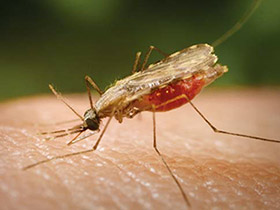 For a female mosquito, it's vitally important to be able to suck blood very quickly. Her suction system must therefore be 100% compatible with the structure of her host's blood.
For a female mosquito, it's vitally important to be able to suck blood very quickly. Her suction system must therefore be 100% compatible with the structure of her host's blood.
Unlike most liquids, blood changes its viscosity according to the diameter of the tube through which it flows. In wide tubes, the alluvia can move easily since they are randomly distributed in the liquid plasma. Yet in minute tubes smaller than a tenth of a millimeter across, the viscosity of blood starts to increase. In tubes of that size, the red blood cells flatten out and concentrate in the middle of the tube. In tubes smaller than a hundredth of a millimeter in diameter, the viscosity of the blood reaches its highest level, because the diameter of the blood cells has approached that of the tube itself. Sucking blood has become as difficult as sucking peas through a straw.
Creatures that feed by sucking blood display a most surprising compatibility. The feeding tubes of mosquitoes and other blood-sucking creatures never falls below one hundredth of a millimeter in diameter.( "Boceklere Ziyafet" (A Feast for Insects), Bilim ve Teknik, October 1997, p. 63) Thanks to this they never experience any difficulty in ingesting blood.
It's worth noting that there are no exceptions in this regard: The same perfection is evident in all blood-sucking creatures. Could all of them have measured the diameter of blood cells and designed their feeding tubes accordingly? Or could they have carried out various experiments to determine a tube wide enough to allow blood cells to pass, but small enough not to restrict the cells' movement capacities? If so, then how did those individuals who were successful at the first attempt manage to transmit that information and thus save subsequent generations from extinction?
Of course, none of these things could possibly have happened. No insect can be aware of the structure of another living thing's blood, and that various cells within that blood affect the blood's viscosity.
No rational person would ever imagine such things upon learning that the mosquito's bodily structure is entirely compatible with blood sucking, or imagine that some insect discovered all this for itself one day. It is clear that such compatibility could not come about by chance.
In order for the mosquito to suck blood, it's not sufficient for it to possess a tube through which blood cells can pass. Above all it needs a force to make the blood move through the tube, and a way to produce that force. There are muscles in the mosquito's head, and as the muscles expand and contract, there is a fall in pressure. As a result, blood begins moving up the feeding tube.
There is only one explanation for the mosquito's perfect mechanisms: It is God Who creates them. The blood cell and the tube through which it passes were both created by a power, together with all the properties they possess. That power is God, the omniscient and flawless Creator.


